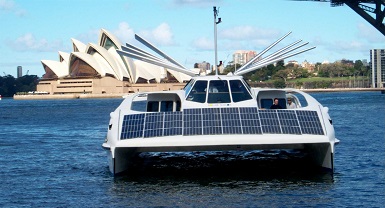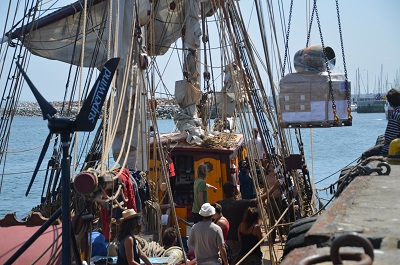Sail Power is Just for the Romantics
(1).jpg) This year has seen the start of a testing program in Japan for fiber-reinforced plastic sails 20 meters high and eight meters wide. Are we at the dawn of a wind power revolution as some say?
This year has seen the start of a testing program in Japan for fiber-reinforced plastic sails 20 meters high and eight meters wide. Are we at the dawn of a wind power revolution as some say?
The testing is part of the Wind Challenger project. Oshima Shipbuilding, the University of Tokyo and NYK Line are developing a next-generation cargo ship using sails that could cut fuel costs by 30 per cent. The long-term goal is to commercialize a hybrid cargo ship that can navigate using either diesel engines or sails twice the size of those currently being tested.
.jpg) As recently as the 1960s and 70s, there were large sailing cargo vessels operating efficiently around the coast of France, Germany, Netherlands and Great Britain. However, they were pushed out of business by road, lorry and oil interests.
As recently as the 1960s and 70s, there were large sailing cargo vessels operating efficiently around the coast of France, Germany, Netherlands and Great Britain. However, they were pushed out of business by road, lorry and oil interests.
These days, sails are relegated to the boutique market. For example, Club Med 2 is a five-masted computer-controlled sailing cruise ship owned and operated by Club Med. It combines the power of seven computer-operated sails with diesel-electric power.
For the past two years Transoceanic Wind Transport (TOWT) of France has been reviving local interest in sail power by chartering up to 10 sailing ships to transport premium products around the region. Among the ships used is the 32m Dutch Fair Transport’s Tres Hombres, an engine-free vessel with an oak and douglas fir hull that has been carrying 35 tonnes of cargo including oak matured rum sailed in from the Caribbean.
Rather than being a romantic notion, the company is building the profile of wind power in readiness to build their own, larger diesel-electric/sail hybrid ecoliners with expanded cargo capacity.
There are plenty of enthusiastic designers for these new-generation wind-powered cargo ships. Sauter Carbon Offset Design has developed various designs including the DynaWing Solar Hybrid Supertanker. Eco Marine Power is developing wind/solar solutions for a range of ship types including bulk carriers, tankers and ferries. B9 Shipping is developing 100 per cent renewably powered sailing hybrid cargo ships.
Innovation on the design bench continues with recent reports in the Norwegian press of ship designer Terje Lade’s aerodynamic hull that acts as a giant sail promising 60 per cent fuel savings. The design could carry up to 7,000 cars. The very tall hull works like a ship’s sail and is expected to be capable of using the apparent wind created by the forward motion of the vessel.
.jpg) There’s also a retrofit design market. Dr Frank Berté, president of Innovative Marine Technology in the US, has developed an outrigger sailing concept Cargoproa particularly suited to diesel powered cargo and tanker vessels that voyage at around a reduced speed of 12 knots. The Cargoproa would stay outside the territorial limits near the originating port or the destination port and be coupled or decoupled at these locations without ever entering the port area. The Cargoproa provides an outrigger, masts and sails as well as a large rudder and dagger board to convert a tanker or cargo vessel into an efficient sailing ship.
There’s also a retrofit design market. Dr Frank Berté, president of Innovative Marine Technology in the US, has developed an outrigger sailing concept Cargoproa particularly suited to diesel powered cargo and tanker vessels that voyage at around a reduced speed of 12 knots. The Cargoproa would stay outside the territorial limits near the originating port or the destination port and be coupled or decoupled at these locations without ever entering the port area. The Cargoproa provides an outrigger, masts and sails as well as a large rudder and dagger board to convert a tanker or cargo vessel into an efficient sailing ship.
SkySails offers an auxiliary wind propulsion for existing commercial vessels. The company claims a unique advantage in that the kite can generate 5-25 times more propulsive power per square meter of sail area than conventional sails because of this operational location and the ability for the autopilot to perform maneuvers such as figure-8’s to increase the kite’s airspeed. Operating at altitudes of 100-500m means it can take advantage of stronger, more stable wind conditions than generally occur at the ocean surface.
Still, all these wind solutions and many more have been around for a while now, claiming fuel efficiency gains of anything from 5 to 95 per cent. Given we’ve seen seemingly more outlandish ideas, such as the Mitsubishi Air Lubrication System which claims around 7 per cent in fuel savings, why haven’t any of these sail ideas made it out of R&D and into the market in a significant way?
 One reason is a healthy scepticism on the part of shipowners. Dr Robert Dane, CEO of Australian company Solar Sailor, has tackled this problem. He used NASA satellite/buoy/ship cross calibrated ocean wind direction and strength data over 22 years to try and demonstrate the potential of wind power. By analysing current shipping routes and calculating historical averages, he estimates that a modern tanker or bulker retrofitting his company’s new opening wing sails, can yield fuel savings of 20-25 per cent on cross-equator routes and 30-40 per cent on same-hemisphere routes. Return on investment for the sails at today’s fuel prices is estimated to be 1-2 years.
One reason is a healthy scepticism on the part of shipowners. Dr Robert Dane, CEO of Australian company Solar Sailor, has tackled this problem. He used NASA satellite/buoy/ship cross calibrated ocean wind direction and strength data over 22 years to try and demonstrate the potential of wind power. By analysing current shipping routes and calculating historical averages, he estimates that a modern tanker or bulker retrofitting his company’s new opening wing sails, can yield fuel savings of 20-25 per cent on cross-equator routes and 30-40 per cent on same-hemisphere routes. Return on investment for the sails at today’s fuel prices is estimated to be 1-2 years.
Dane hasn’t had any luck with his bulk carrier yet, but he has had success with ferries. His latest invention is unmanned autonomous vessels with sails. He has a model for surveillance and one for oceanography.
 While not an industry-wide solution, wind power does seem to demonstrate greater potential than many other fuel-saving technologies on the market. Perhaps the fact that the air lubrication system, and also hull appendages that improve efficiency, have been developed by a shipyard explains why sail power lags behind the other options. It is difficult and expensive to get shipyards to change their designs. It seems innovations need to be optimised for and by the shipbuilding industry before they can make it out of the test tank.
While not an industry-wide solution, wind power does seem to demonstrate greater potential than many other fuel-saving technologies on the market. Perhaps the fact that the air lubrication system, and also hull appendages that improve efficiency, have been developed by a shipyard explains why sail power lags behind the other options. It is difficult and expensive to get shipyards to change their designs. It seems innovations need to be optimised for and by the shipbuilding industry before they can make it out of the test tank.
Perhaps the Wind Challenger project, then, signals in a new era of wind power. Can the shipyard and its partners take the romance out of wind power and replace it with a credible, high-tech future in 2014.
Photo credits:
Diana MESA - TOWT.eu
Solar Sailor
Diamantino Rosa
